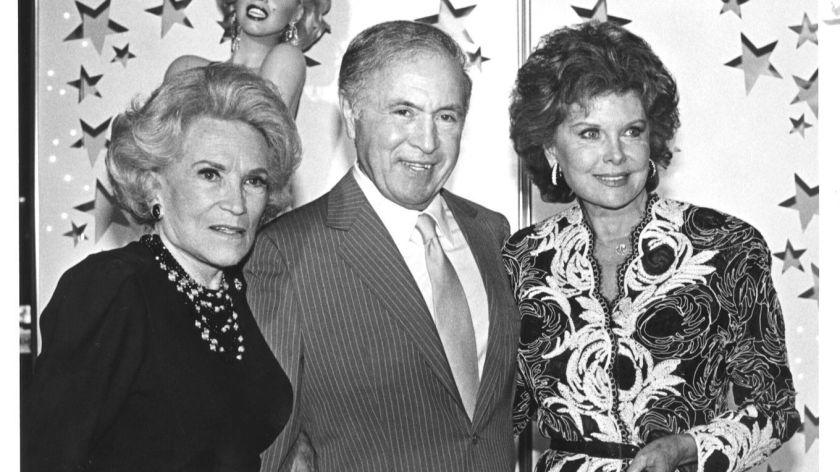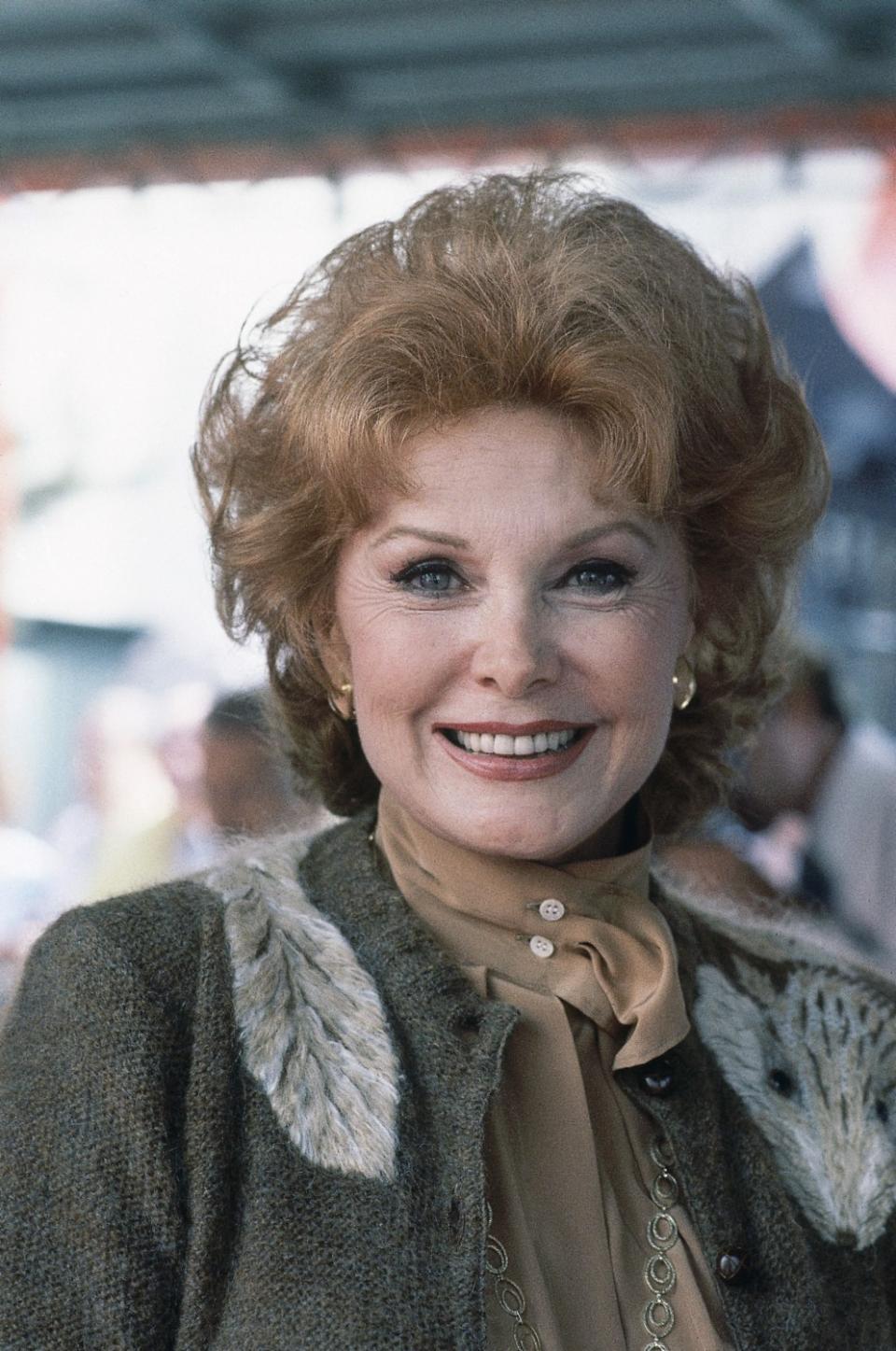Golden Age actress and singer Rhonda Fleming has died at 97

Rhonda Fleming, the green-eyed, auburn-haired actress who was known as the Queen of Technicolor during Hollywood’s Golden Age and who made a mark as a philanthropist by channeling her wealth and prominence into helping others, has died. She was 97.
Fleming died on Wednesday in a Santa Monica hospital, her assistant, Carla Sapon, told the New York Times.
As a budding Beverly Hills High School teenager in the early 1940s, Fleming caught the eye of a talent scout for producer David O. Selznick. Selznick cast her in the 1945 Alfred Hitchcock film “Spellbound” and launched an international star.
Fleming deployed her talents as an actress and singer in starring roles opposite the top leading men in Hollywood, including Bing Crosby, Rock Hudson, Charlton Heston, Kirk Douglas, Burt Lancaster and Ronald Reagan. Producers quickly discovered the striking visual impact of her eyes, hair and creamy skin in Technicolor, which put Fleming in high demand for the westerns, period pieces and jungle adventure movies of the 1940s and ‘50s.
But while Fleming never made, in her words, “a classic like 'Casablanca,'" she proved herself a versatile actress who took on challenges. She stood out as the secretary who frames Robert Mitchum’s private eye character in the celebrated 1947 film noir “Out of the Past,” and as the villainous stepsister in the 1958 psychological drama “Home Before Dark.”
Her career, which spanned more than 40 films and numerous television parts, epitomized that of a true Hollywood working professional, said Jeanine Basinger, a film historian and author of “A Women’s View: How Hollywood Spoke to Women.”
“She had what you would call a journeyman’s career, in the most positive sense,” said Basinger, a professor of film studies at Wesleyan University. “She endured. She labored. But she was on top of it. She could appear in any kind of movie.”
She could sing, too — and a lifelong ambition to do so blossomed in 1957, when Fleming stepped out onto the stage of the newly opened Tropicana nightclub in Las Vegas to rave reviews. She also appeared on Broadway, performing in a 1973 revival of Clare Booth Luce’s “The Women.”
The actress was married six times, including for 23 years to Ted Mann of Mann Theaters, until he died in 2001.
Throughout her career, Fleming said she disliked the Queen of Technicolor moniker, preferring to point instead to her professional accomplishments.
Fleming was born Marilyn Louis on Aug. 10, 1923, in Hollywood. A flair for the stage ran in her veins — her mother, Effie Graham, was a well-known model and actress who once appeared opposite Al Jolson in a musical production at New York’s Winter Garden Theater.
But the thought of acting never crossed Fleming's mind. She wanted to be a singer, like her idol, the Canadian vocalist and actress Deanna Durbin. An aunt gave her voice lessons and she entered singing contests.
“I never asked to be in motion pictures,” Fleming told the Las Vegas Review-Journal in 2009. “It just happened with the studio system. I wanted to sing. I studied to be a trained singer, and I worked at it, and trained at it.”
Yet her fortunes took a fairy-tale turn toward film when Henry Willson, a talent agent for Selznick, spotted her outside Beverly Hills High. Without even giving her a screen test, Selznick cast her as a violently seductive mental hospital patient in “Spellbound,” which also starred Gregory Peck and Ingrid Bergman.
“When I got the part, I ran home and told my mother I was going to play a nymphomaniac,” Fleming later recalled. “‘A what!’ my mother cried. I had no idea what the word meant!”
Selznick wanted to bestow his young film star with a new name. By then, Marilyn Louis was Marilyn Lane, married to decorator Thomas Lane in 1940. Convinced that Marilyn “wasn’t commercial” (a theory belied a few years later by Marilyn Monroe), Selznick came up with Rhonda Fleming — a name she had to warm up to at first.
Her star rose along with the use of Technicolor, starting with the 1949 musical “A Connecticut Yankee in King Arthur’s Court” (co-starring Crosby) and a series of westerns, including “The Redhead and the Cowboy” and “Gunfight at the O.K. Corral.” But Fleming later indicated she felt that color cheated her of the meatier parts she landed in black-and-white films.

Beginning in the late 1970s, Fleming mostly retired from acting to devote herself to work with various charities. She used her star power to support numerous causes, volunteering at UCLA and opening the swimming pool at her Bel-Air home to children stricken with cerebral palsy.
Her philanthropy went in a new direction after her older sister Beverly died in 1990 of ovarian cancer. In an interview with the Los Angeles Times, Fleming recalled the moment when her sister, a steady source of moral support for Fleming, called and asked for advice about surgery. Fleming sat down at her telephone and spent the next 12 hours making calls.
“My sister would have killed for me, and now I had to keep her alive,” Fleming said.
What struck her most about her sister’s fight with cancer, Fleming said, was a lack of psychological support services for patients. When she and Mann were preparing to open the Rhonda Fleming Mann Resource Center for Women with Cancer at UCLA, Fleming picked out the color scheme, art and furniture with the idea of a comforting environment in mind.
A plaque in the reception area bears her sister’s name, and a quote: “Make it a place of hope.”
Besides her involvement with other charitable organizations, Fleming served on the board of People Assisting the Homeless and established a center to provide temporary housing for single women and children.
Married most recently to Darol Wayne Carlson, who died in 2017, Fleming is survived by her son, Kent Lane and two granddaughters, five great-grandchildren and two great-great-grandchildren, Sapon relayed to the New York Times.
This story originally appeared in Los Angeles Times.
